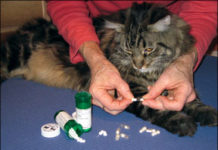Luckily, cats do not experience the high frequency of seizures that can plague many dogs, but seizuring cats face the extra challenge of trying to find a safe, effective medication. A recent study looked at an extended-release version of the medication levetiracetam.
“Many anti-epileptic drugs have limited utility in cats either due to their intolerable side effects (such as potassium bromide), their short half-lives (such as phenytoin), lack of efficacy as a sole agent (gabapentin, pregabalin), or the fact they are not widely available in many countries (zonesamide, imeptoin). As such, phenobarbital has remained the mainstay of seizure control in many cats, with levetiracetam a commonly used alternative. Both of these drugs require two to three doses to be given per day, which may be untenable for many cat owners,” says the Winn Feline Foundation.
Volunteers for the study were nine pet cats, all over 10 lbs. in body weight. Size was important since the only version of extended-release levetiracetam currently available is a 500 mg dose. Owners gave one pill each day and tracked appetite, behavior, and any adverse events. The study went smoothly, with only minor problems noted, including some vomiting by one cat and mild sedation and ataxia briefly by two others. Serum levels were well above those needed to control seizures.
Obviously, this study is a preliminary step toward the use of extended-release levetiracetam for seizure control in cats. Sample size was small, and the cats were healthy and of a set size. Also, seizure medications are given for longer periods of time than in this study. Still, it is a first step, and in the future cat owners with difficult-to-pill cats may find this to be an acceptable alternative. n
Barnes Heller H, Granick M, Van Hesteren M, Boothe DM. Serum levetiracetam concentrations and adverse events after multiple doseextended release levetiracetam administration to healthy cats. J Vet Intern Med.2018 Apr 19. doi: 10.1111/jvim.15129.



